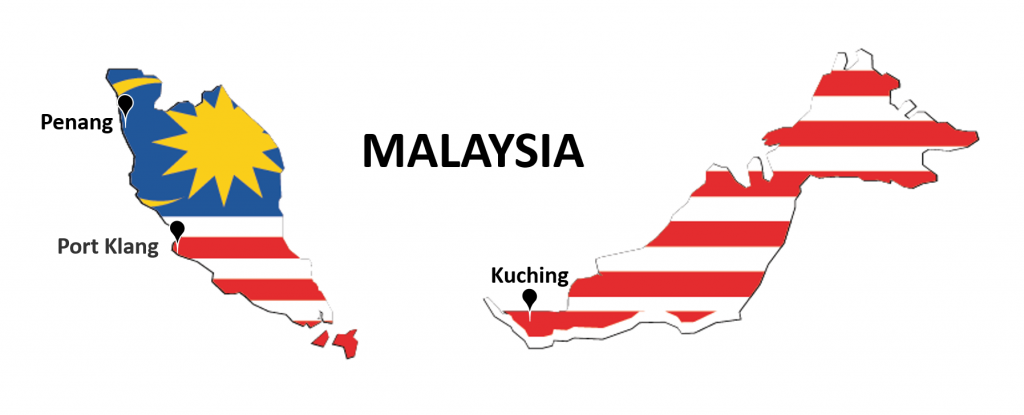Main sea ports of Malaysia
General information about Malaysia
Malaysia is a federal constitutional monarchy country located in the south of Southeast Asia. The country is divided into 13 states and three federal territories with a total land area of 330,803 km². East sea separates Malaysia into two parts: Peninsular Malaysia and Malaysian Borneo. Malaysia land borders with Thailand, Indonesia, and Brune, and sea borders with Singapore, Vietnam, and the Philippines. The capital city is Kuala Lumpur, but the federal government is located in Putrajaya.
Population: 32,4 million people
Malaysia is a multi-ethnic and culturally diverse country, a feature that plays an important role in the national political system.
Since independence, Malaysia has become one of the most developed economies in Asia, the average GDP has been about 6.5% for nearly 50 years and reached a high level in the human development index. Traditionally, natural resources are the driving factor for Malaysia’s economy, but the country is also developed in heavy industry, science, tourism, commerce, medicine, and health.
Today, Malaysia’s industry market is regarded as a developed industrial market economy, the country has the 3rd largest nominal GDP in Southeast Asia after Thailand and Indonesia, 11th in Asia and 33rd in the world. Malaysia is a founding participant of the Association of Southeast Asian Nations (ASEAN), the East Asia Summit and the Islamic Cooperation Organization, and a member of global organizations such as the United Nations, WTO, and Forum for Asia-Pacific Economic Cooperation, the Commonwealth of Nations and Non-aligned Movement.

Ảnh: malaysia
Main sea ports of Malaysia

1. PENANG PORT
The Port of Penang, located in the northwestern part of Peninsular Malaysia, is considered Malaysia’s oldest port. The port acts as the main gateway for businesses in the northern states of Malaysia and also in the southern provinces of Thailand. The port is strategically located along the Strait of Malacca, one of the busiest shipping routes in the world. Fully equipped to handle all types of cargo such as containers, liquids, dry cargo, bulk cargoes and others; and provide a multitude of services to facilitate safe and efficient transportation through the various ports and port facilities. In order to further improve the port’s operational efficiency and further enhance its services, the Port of Penang recently privatized.
Being a Container Port is the core activity of the Port of Penang with base on the North Butterworth Container Port (NBCT). The port is equipped with 6 berths (N1 to N6) with a total length of 1.5 km and 13 Gantry Cranes (QGCs). Seven out of these 13 cranes are the QGC Panamaxes which are capable of handling ships with 18 rows of containers with a transport speed of 25 times per hour by each crane. The current berth capacity is 2 million TEUs per year. In addition, the port also includes 8 rail-mounted cranes (RMG) providing 2,244 spaces in the export cargo area located on the jetty for faster and efficient load operations. A container yard with an area of nearly 59.24 Hectares provides approximately 7,104 seats on the ground as well as 1,000 space for reefer cargo. The dock warehouse provides a full range of container services such as surveying, repairing, and cleaning as well as services related to refrigeration cargos such as inspection, etc.
Butterworth Wharves has been operating since 1969, construction cost was about 60 million RM. The Harbor area is up to 60.7 hectares with an anchor berth of 1.05 km long. The complex warehouse is 38,000 m2 large, designed to hold nearly 50,000 m3 of cargo. The port is also equipped with a variety of cargo handling equipments such as forklifts, movers and trailers. The pier is linked to the hinterland through the national highway system and the national railway system. Penang Port’s cargo handling performance standards are ISO certified. Each year, 2.5 million tons of cargo are handled by Butterworth Wharves.
From 1975 to 1980, a separate dock called the Perai Bulk Cargo Terminal (PBCT) was built to handle both dry and liquid cargo . PBCT dock has an area of about 33.99 hectares located in the southern of the Perai power plant and the northern of Penang Bridge No. 1. The construction investment cost of the government for this activity was 48.79 RM million. It has equipped with 111,000 m2. storehouse; 4.6 hectares of outdoor warehouse; 1 gantry and 2 mobile cranes at the head of the jetty to speed up loading and unloading. The five anchorages with a total length of 632m can handle 3.9 million tons of cargo per year, including 500m used for conventional dry cargo. The 132m left is used to handle dangerous cargo in liquid form and gas form
2. PORT K’LANG
Klang is the center city of Selangor state, Malaysia, located in the Klang district in the Klang valley, 32km from the west of Kuala Lumpur and 6km from the east of Klang port.
Port Klang is the 13th busiest transshipment port and the 16th busiest container port in the world. During the colonial period, the port was known as Swettenham Port but was renamed K’lang Port in July 1972. The Port Authority of Klang managed three ports in the Port Klang area: Northport, Southpoint and Westport. Before the establishment of the Klang Port Authority, South Port was the only existing port which was managed by the Malaysian Railway Authority. Both Westport and Northport have been privatized and managed as separate entities.
– Northport
Northport is owned and operated by Northport (Malaysia) Bhd and includes dedicated multipurpose port facilities and services. The Northport entity is the merge of two companies: Kelang Container Port (KCT) and Kelang Port Management (KPM). The company’s operations also included activities of SouthPort, which was renamed Southpoint for general cargo handling. The company also purchased Northport Distripark Sdn Bhd (NDSB) as part of the logistics division.
– Westport
Westport is managed by Westports Malaysia Sdn Bhd (formerly known as Kelang Multi Terminal Sdn Bhd).It is a passenger port, Port Klang Cruise Center. Westport was opened in December 1995 at Pulau Indah, located next to Westport’s cargo terminals. Cruise ships and naval vessels are moored at any of the three berths at Port Klang Cruise Center, under the management of Star Cruise before being taken over by Glenn Marine Group. Cargo docked at the container terminal is received at 33 anchorages, the total length of them are about 9,000m with an annual capacity of 19.6 million TEUs of cargo, included 3,480 TEUs are reefer. For bulk cargo, the port is equipped with 8 anchorages, stretching over 1400m, warehouse area 53,860 m2, outdoor warehouse area with 137,737 m2 wide. In addition to container and bulk cargo, Klang Port also serves liquid cargo with the number of anchor berths of 9, length 2,086.4m
3. PORT KUCHING
Kuching is the capital and most populous city of the state of Sarawak. Kuching is a major culinary destination for tourists and also the main gateway for visitors to visit Sarawak and Borneo. Kuching Wetland National Park is about 30 kilometers from the city, and there are many other tourist attractions in and around Kuching such as Bako National Park, Semenggoh Wildlife Center, Rainforest World Concert ( RWMF), State Parliament Building, Astana Palace, Fort Margherita, Kuching Cat Museum, and Sarawak State Museum. In addition, the city has become one of the industrial and commercial hubs in East Malaysia.
New Kuching Central Business District, Pending Industrial Park, Demak Luat Industrial Park, Sama Jaya Free Industrial Park and the suburbs of Petra Jaya is constructed with the aim of promoting the city’s industrial and commercial activities to make it become the most develop centers in East Malaysia, as well as for BIMP-EAGA (East ASEAN Development Area). The city is also home of numerous conferences, seminars and trade fairs such as the Malaysia Global Business Forum, the Leaders of the Future Summit, and the International Hydropower Association’s World Conference (IHA), ASEAN Tourism Forum, and other conferences. These events are usually held at the Borneo Convention Center.
Covering an area of 31.94 hectares, the Kuching port has an annual capacity of nearly 10 million tons of cargo with 2 main berths
– Pending port is 31.94 hectares, it is equipped with an anchoring berth of 613 meters in length. In particular, the transit area is 33,201 square meters, 450 square meters for the dangerous goods area, 30,000 square meters for the outdoor area and the parking area is 75,000 square meters.
– Senar wharf is twice as large as Pending port (60 hectares). It is designed to handle more goods. The pier can provide an average cargo capacity of up to 7 million tons per year due to a 182,500 square meter container yard, a 20000 square meter transit area. An advantage of Senar Wharf compared to the Pending Wharf is that it also provides the 192 square meters and CFS retail is 8,000 square meters of cold storage.
Logistics HP Global Vietnam
Freight forwarder, Customs Broker and Vietnam Import/export license
Building No. 13, Lane 03, N003, Van Khe, Ha Dong, Hanoi
Website: hpgloballtd.com
Email: info@hpgloballtd.com
Phone: ++84 24 73008608 / Hotline: ++84 984870199/ ++84 8 8611 5726
Note:
– The article is for reference only, prior to using the content, it is suggested that you should contact HP Global for whether any update
– HP Global keep it full right copy right of the article. No copy for commercial purpose is approved.
– Any copy without approval by HP Global (even note quote from website hpgloballtd.com/hptoancau.com) can cause to our claim to google and related agencies.
 Tiếng Việt
Tiếng Việt  English
English  简体中文
简体中文 







